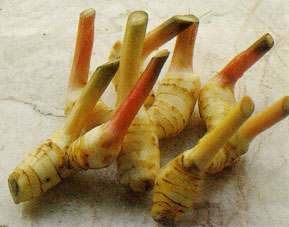|
|||||
|
|||||||
|
    An initiative of :Stichting Food-Info
|
| Food-Info.net> Food Products > Spices Greater galanga (Alpinia galanga)Plant familyZingiberaceae (ginger family). Botanical synonymsLanguas galangal OriginSouth East Asia, probably southern China; it is now cultivated in Indochina, Thailand, Malaysia and Indonesia. Used plant partThe ginger-like rootstock (rhizome). It is built up from cylindrical subunits (circular cross-section), whose pale-reddish surface is characteristically cross-striped by reddish-brown, small rings. The interior has about the same colour as the skin and is hard and woody in texture. Although galanga leaves are aromatic, they are not often used for flavouring purposes. The same holds for the seeds, which could be used in place of cardamom. Sensoric qualityWarm, sweet, spicy. Fresh galanga has a distinct fragrance that reminds of fir or pine needles; dried galanga is more spicy and sweet-aromatic, almost like cinnamon. Main constituentsThe rhizome contains up to 1.5% essential oil (1,8 cineol, a-pinene, eugenol, camphor, methyl cinnamate and sesquiterpenes). In dried galanga, the essential oil has quantitatively different composition than in fresh one. Whereas a-pinene, 1,8-cineol, a-bergamotene, trans-ß-farnesene and ß-bisabolene seem to contribute to the taste of fresh galanga equally, the dried rhizome shows lesser variety in aroma components (cineol and farnesene, mostly). (Phytochemistry, 24, 93, 1985)
 Fresh galanga rhizome UseGreater galanga, mostly referred to simply as or galanga, is a very popular spice in whole South East Asia and especially typical for the cuisine of Thailand. It is also known and used in Malaysia, Indonesia, Cambodia, Vietnam and Southern China. Chinese five spice powder is sometimes enhanced with galanga. In Western countries, however, galanga is not well known, at least in our days; it has, however, been a valued spice in the early Middle-ages. Galanga may be used fresh or dried, which makes a great difference in flavour. Fresh galanga has a pure and refreshing odour and a mildly spicy flavour; it is the galanga of choice for all Thai foods, where it is often added to soups (e.g., tom khaa, a variety of tom yam with galanga and coconut milk) in form of thin slices; for stir-fries, it is more often used finely cut or chopped, and ground fresh galanga rhizom is an essential ingredient in most curry pastes . Like ginger, its aroma merges well with garlic. Dried and powdered galanga is less fresh but more spicy, something in between of ginger and cinnamon. Dried galanga is also sold if form of slices that must be reconstituted in warm water and come closer to fresh galanga in their flavour. In most South East Asian countries dried galanga is employed only whenever fresh galanga is not available. Indonesians, for example, frequently use slices or powder of the fresh or dried rhizome, e.g., for nasi goreng (fried rice with vegetables and meat) or for the characteristically sweet Jawanese curries. Source : www-ang.kfunigraz.ac.at/~katzer/engl/spice_welcome.html |
|
| ||
| Food-Info.net is an initiative of Stichting Food-Info, The Netherlands | ||||||